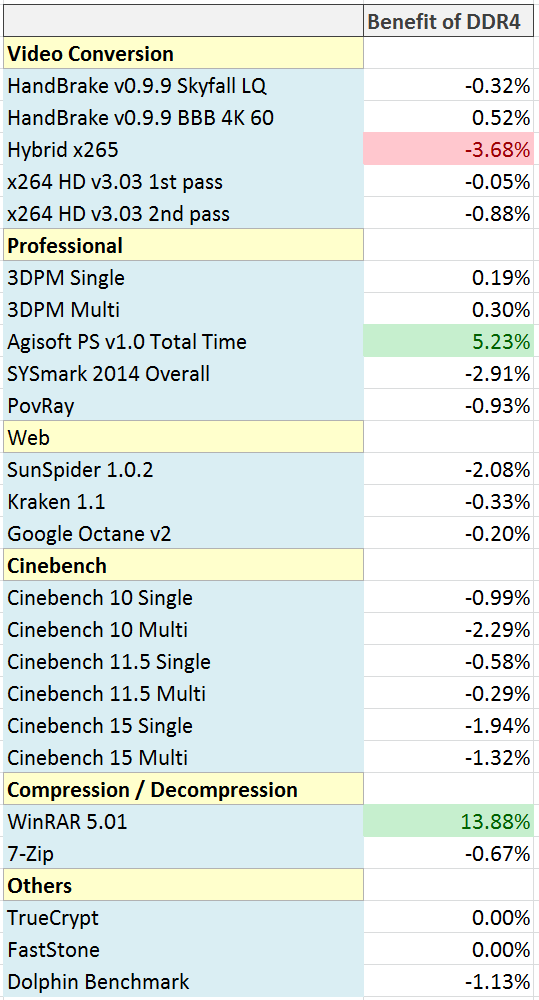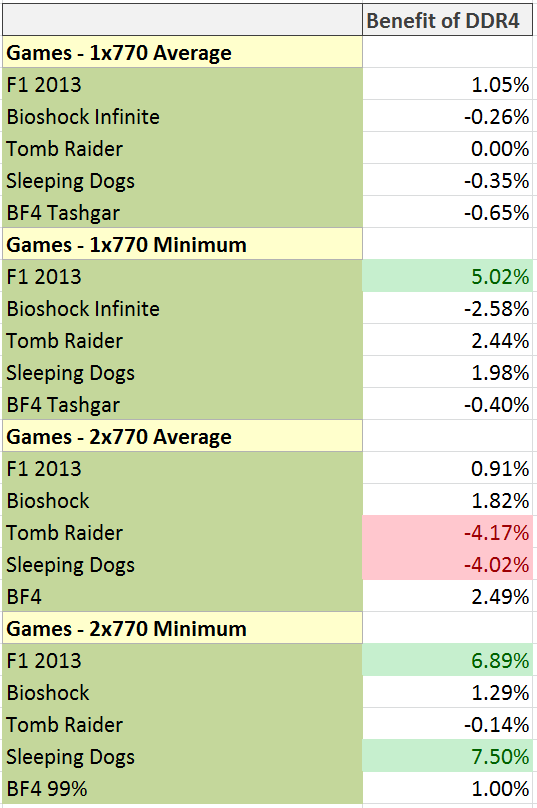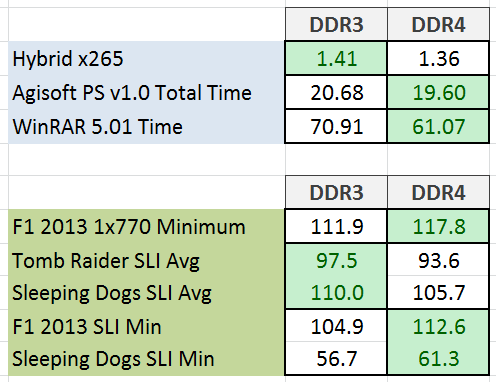DDR4 Haswell-E Scaling Review: 2133 to 3200 with G.Skill, Corsair, ADATA and Crucial
by Ian Cutress on February 5, 2015 10:10 AM ESTComparing DDR3 to DDR4
Moving from a standard DDR3-2133 C11 kit to DDR4-2133 C15, just by looking at the numbers, feels like a downgrade despite what the rest of the system is. Ideally we want the first number, the frequency, to be high and the second number, the latency, to be low. After spending several years dealing with DDR3, moving to DDR4 feels a bit of a backwards step when you look at solely the numbers on paper.
As part of this review we have covered many different areas where DDR4 is the upgrade of DDR3, not only in terms of voltage but some of the underlying concepts as well. This puts DDR4 in a position for upgradability in the future, especially when it comes to density and future technologies (see the next page for more information). But an ultimate question still remains: at the same frequency and latency, do they perform the same?
The only way to perform an identical comparison would be to have a platform that could probe both DDR3 and DDR4 while keeping the same CPU. If one comes along, we will test that, but in the mean time we can do some broad comparisons with near-identical systems.
For this test we took two Haswell based systems and compared them against each other. The first contains the Haswell-E i7-5960X processor, cut it down to run at four cores with no HyperThreading, fixed the CPU speed at 4 GHz and placed the memory into DDR4-2133 14-14-14 350 2T timings. We did the same with the second system, a Haswell based i7-4770K moved it to 4 GHz and making sure it was in 4C/4T mode. The OS was placed into a unique high performance profile and we ran our test suite. The only difference that remained between the two setups was the L2 and L3 cache, which we cannot change unfortunately.
In our non-gaming tests, there is one situation where DDR3 is more than 3% better and two where DDR4 is +3%. It is worth noting that most of the numbers, especially with things like the Web and Cinebench are actually slightly negative.
In the gaming tests, similarly there are more +3% on the side of DDR4. If we do a direct comparison regardless of the percentage, DDR4 wins 11 times compared to DDR3 getting 8, and almost of DDR3’s wins are minor except for two-way SLI. It would seem that for two-way SLI DDR4 at least brings up some of the minimum frame rates.
Pulling out the >3% difference numbers, just to see what the numbers exactly are:
On the face of it, the Hybrid result does not seem that different, whereas a full minute on Photoscan or 10 seconds in our WinRAR test feels like a difference. In the gaming tests moving nearer to 120 FPS or 60 FPS, especially in both of the minimum frame rate tests, is an important jump which happens with DDR4.
Overall, comparing DDR4 to DDR3, there is little difference to separate the two. In a couple of small instances one is better than the other, but on those edge cases it might be prudent to say that we cannot make a final decision until we can synchronize the rest of the system, such as the size of CPU caches. When we can perform such tests, we will run some more numbers.













120 Comments
View All Comments
galta - Thursday, February 5, 2015 - link
Yes, yes, it is wrong: whoever spends money on "enthusiast" RAM has more money than brains, except for some very specific situations.The golden rule is to buy a nice standard RAM from a reputable brand and use the savings to beef-up your CPU/GPU or whatever.
Murloc - Thursday, February 5, 2015 - link
yeah but e.g. with corsair ram I always bought the mainstream XMS one instead of the Value Select sticks, but given that I haven't done any tweaking in my last rig, I might just as well have bought the cheaper one without the heatsinks.Maybe in my next build I will do that if there is a significant price difference.
galta - Thursday, February 5, 2015 - link
You just proved my point: crucial is pretty reputable and they have no thrills RAM that are generally the cheapest on the market.Corsair is always fancy ;)
Kidster3001 - Friday, February 6, 2015 - link
The word "Enthusiast" with respect to computers is synonymous with "Spends more than they need to because they want to." If you're making the Price/Performance/Cost purchase then you are not an Enthusiast. Every year I spend money on computer stuff that I do not need. Why? Because I am an Enthusiast. You may consider this "wasting money", perhaps it is. I don't "need" my 30" monitor or my three SSD's or my fancy gaming keyboard and mouse. I did spend money on them though. It's my hobby and that's what hobbies are for.... spending money you don't need to spend.Stick with your cost conscience, consumer friendly computer parts. They are good and will do what you need them to do. Just don't ever try to call yourself an Enthusiast. You'll never have the tingly feeling of powering up something that is really cool, expensive and just plain fun. Yeah, it costs more money but in reality, that's half the fun. The tingly feeling goes away in a month or so. That's when you get to go "waste" more money on something else. :-)
sadsteve - Friday, February 6, 2015 - link
Hm, I don't necessarily agree with you on size. With the size of digital photos today, a large amount of RAM gives you a lot more editing cache when Photoshopping. I would also imagine it's useful for video editing (witch I don't do). For all my regular computer use, yeah 16GB of RAM is not too useful.Gunbuster - Thursday, February 5, 2015 - link
So a 4x4 2133 kit for $200 or a 3333 kit for $800 and 2% more speed in only certain scenarios. Yeah seems totally worth $600 extra.You could buy an extra Nvidia or two AMD cards for that and damn sure get more than 2-10% speed boost.
FlushedBubblyJock - Sunday, February 15, 2015 - link
Shhh ! We all have to pretend 5 or 10 dollars or maybe 25 or 50 is very, very ,very very important when it comes to grading the two warring red and green video cards against each other !just4U - Thursday, February 5, 2015 - link
Is there no way for memory makers to come up with solutions where they improve the latencies rather than the frequencies? The big numbers are all well and good at the one end but the higher you go at the other end offsets the gains.. at least that's the way it appears to me.menting - Thursday, February 5, 2015 - link
there is. The latency is due to physical contraints, so you can improve it by stacking (technology is just starting to slowly become mature for this), or by reducing the distance a signal needs to travel, which is done by smaller process size as well as shortening the signal distance (smaller array, smaller digit lines, etc). But shortening the signal distance comes at a cost of either|or|and smaller DRAM density, more power, etc, so companies don't really do it since it's more profitable to make larger density DRAM and/or lower power DRAM. The only low latency DRAM I know of is the RLDRAM, which has pretty high power and is fairly expensive.ZeDestructor - Thursday, February 5, 2015 - link
That, and with increasingly larger CPU caches, less and less of an issue as well.